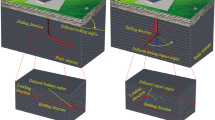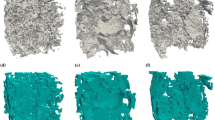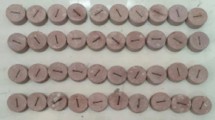Abstract
The freezing and thawing processes in sandstones under unsaturated conditions are methodically explored via the low-field nuclear magnetic resonance (NMR) technique. To precisely monitor the water content and distribution during the freezing and thawing processes, a special Carr–Purcell–Meiboom–Gill (CPMG) pulse sequence is proposed, leading pulse-induced temperature perturbations to be minimized. The results exhibit totally dissimilar water distributions in the two processes even under the same saturation: the freezing process retains more water in large pores, while the thawing process contains less water in large pores. This observation is primarily attributed to the ink-bottle effect occurring during the freezing: large pores with narrow entrances do not freeze until the entrance freezes. In addition, phase transition duration depends on the initial water saturation, for instance, the duration of the thawing process increases from 7 to 12 min as the initial water saturation varies from 40% to 80%. Through NMR observation, this phenomenon is associated with the variation of surface-to-volume ratio: high saturation is associated with the presence of water in large pores; the latter owns a small surface-to-volume ratio and accordingly involves a longer phase transition duration. After the assessment of surface-to-volume ratio, the intrinsic kinetic rate coefficient is further estimated to be 4.6 × 10–12 mol cm−2 s−1 ℃−1 for the ice thawing process in the studied rock. This value is five orders of magnitude lower than that found in the literature for the thawing process in bulk condition, i.e., 7.5 × 10–7 mol cm−2 s−1 ℃−1. We suggest that the small intrinsic kinetic rate coefficient addressed in the present work could be related to the constrained effect in rocks.
Highlights
-
A special pulse sequence with minimized temperature perturbation is developed to perform the freezing/thawing experiment.
-
The difference in water distribution is attributed to the effect of ink-bottle pores in the freezing and thawing processes.
-
Phase transition time increases with initial water saturation, which is lucidly explained by the nuclear magnetic resonance measurement that directly gives rise to information about the surface-to-volume ratio.
-
The intrinsic kinetic rate coefficient for ice melting within sandstones is estimated.














Similar content being viewed by others
Data availability
The authors confirm that the data supporting the findings of this study are available within the article.
Abbreviations
- B 0 :
-
Magnetic field intensity
- B i :
-
Biot number
- C :
-
Specific heat
- F p :
-
Shape factor of the pore space
- L :
-
Latent heat
- M, M 0 :
-
Magnetization intensity; the total magnetization intensity
- N :
-
Number of nuclei
- S :
-
Surface
- S w :
-
Water saturation
- T 2 i :
-
Relaxation time for the water in the ith pore space
- T, T env, T m :
-
Temperature; environment temperature; melting point temperature
- V :
-
Volume
- f i :
-
Mass fraction of water in ith pore space
- h :
-
Convection coefficient
- k 0, k i :
-
Intrinsic kinetic rate coefficient; kinetic rate coefficient
- l :
-
Characteristic length
- n 0, n i :
-
Initial moles of the ice; moles of the ice
- r :
-
Pore size
- s :
-
Spin quantum number of the nucleus
- t :
-
Time
- ɸ :
-
Volumetric water content
- γ :
-
Gyromagnetic ratio
- ƞ :
-
Moles of the ice per unit volume
- κ :
-
Boltzmann’s constant
- λ :
-
Thermal conductivity
- ϴ i :
-
Volumetric fraction of the ice
- ρ 2 :
-
Surface relaxivity
- ρ c, ρ i :
-
Density of the rock (c) and ice (i)
- \(\xi\) :
-
Planck’s constant
References
Anderson B (2009) Affective atmospheres. Emot Space Soc 2(2):77–81
Atkins PW, Paula JD (2006) Physical chemistry. In: Physical chemistry, 8th edn. Oxford university press, UK
Boswell R (2009) Is gas hydrate energy within reach? Science 325:957–958
Brownstein KR, Tarr CE (1979) Importance of classical diffusion in NMR studies of water in biological cells. Phys Rev A 19(6):2446
Chu Z, Wu Z, Liu Q, Weng L, Wang Z, Zhou Y (2021) Evaluating the microstructure evolution behaviors of saturated sandstone using NMR testing under uniaxial short-term and creep compression. Rock Mech Rock Eng 54(9):4905–4927
Coussy O (2005) Poromechanics of freezing materials. J Mech Phys Solids 53:1689–1718
Coussy O (2006) Deformation and stress from in-pore drying-induced crystallization of salt. J Mech Phys Solids 54:1517–1547
Coussy O (2011) Mechanics and physics of porous solids. Wiley, New York
Cowan B (2005) Nuclear magnetic resonance and relaxation. Cambridge University Press
Dai J, Zhang T, Qi R, Zhao H, Fei T, Lu G (2017) LiCl loaded cross-linked polymer composites by click reaction for humidity sensing. Sens Actuators B Chem 253:361–367
Daigle H, Thomas B, Rowe H, Nieto M (2014) Nuclear magnetic resonance characterization of shallow marine sediments from the Nankai Trough, Integrated Ocean Drilling Program Expedition 333. J Geophys Res Solid Earth 119(4):2631–2650
Deprez M, De Kock T, De Schutter G, Cnudde V (2020) A review on freeze-thaw action and weathering of rocks. Earth Sci Rev 203:103143
Engemann S, Reichert H, Dosch H, Bilgram J, Honkimäki V, Snigirev A (2004) Interfacial melting of ice in contact with SiO2. Phys Rev Lett 92(20):205701
Essery R (2015) A factorial snowpack model (FSM 1.0). Geosci Model Develop 8(12):3867–3876
Galwey AK, Sheen DB, Sherwood JN (2001) Should the melting of ice be represented as a solid state reaction? Thermochim Acta 375(1–2):161–167
Gruber S, Haeberli W (2007) Permafrost in steep bedrock slopes and its temperature-related destabilization following climate change. J Geophys Res Earth Surf 112:F02S18
Hallet B (2006) Why do freezing rocks break? Science 314(5802):1092–1093
Hasler A, Gruber S, Beutel J (2012) Kinematics of steep bedrock permafrost. J Geophys Res Earth Surf 117:F01016
Hitchcock I, Holt EM, Lowe JP, Rigby SP (2011) Studies of freezing–melting hysteresis in cryoporometry scanning loop experiments using NMR diffusometry and relaxometry. Chem Eng Sci 66(4):582–592
Huang S, Liu Q, Liu Y, Ye Z, Cheng A (2018) Freezing strain model for estimating the unfrozen water content of saturated rock under low temperature. Int J Geomech 18(2):04017137
Jia H, Zi F, Yang G, Li G, Shen Y, Sun Q, Yang P (2020) Influence of pore water (ice) content on the strength and deformability of frozen argillaceous siltstone. Rock Mech Rock Eng 53(2):967–974
Jin HJ, Chang XL, Wang SL (2007) Evolution of permafrost on the Qinghai-Xizang (Tibet) Plateau since the end of the late Pleistocene. J Geophys Res Earth Surf 112:F02S09
Kamal MS, Mahmoud M, Hanfi M, Elkatatny S, Hussein I (2019) Clay minerals damage quantification in sandstone rocks using core flooding and NMR. J Pet Explor Prod Technol 9(1):593–603
Kim HC, Bishnoi PR, Heidemann RA, Rizvi SS (1987) Kinetics of methane hydrate decomposition. Chem Eng Sci 42(7):1645–1653
Kleinberg RL, Griffin DD (2005) NMR measurements of permafrost: unfrozen water assay, pore-scale distribution of ice, and hydraulic permeability of sediments. Cold Reg Sci Technol 42(1):63–77
Latour LL, Li LM, Sotak CH (1993) Improved PFG stimulated-echo method for the measurement of diffusion in inhomogeneous fields. J Magn Reson Ser B 101(1):72–77
Liu JW, Li XS (2021) Recent advances on natural gas hydrate exploration and development in the south China Sea. Energy Fuels 35(9):7528–7552
Liu ZQ, Wang LL, Zhao B, Leng JY, Zhang GQ, Yang DS (2019) Heat transfer in sandstones at low temperature. Rock Mech Rock Eng 52(1):35–45
Liu ZQ, Gong D, Wang LL (2021) Heat transfer with kinetic phase transition in geomaterials. Int J Heat Mass Transf 167:120826
McCreesh CA, Ehrlich R, Crabtree SJ (1991) Petrography and reservoir physics II: relating thin section porosity to capillary pressure, the association between pore types and throat size. AAPG Bull 75(10):1563–1578
McDonald PJ, Korb JP, Mitchell J, Monteilhet L (2005) Surface relaxation and chemical exchange in hydrating cement pastes: a two-dimensional NMR relaxation study. Phys Rev E 72(1):011409
Michalowski RL, Zhu M (2006) Frost heave modelling using porosity rate function. Int J Numer Anal Meth Geomech 30:703–722
Mitra PP, Sen PN, Schwartz LM, Le Doussal P (1992) Diffusion propagator as a probe of the structure of porous media. Phys Rev Lett 68(24):3555
Müller-Petke M, Dlugosch R, Yaramanci U (2011) Evaluation of surface nuclear magnetic resonance-estimated subsurface water content. New J Phys 13(9):095002
Murton JB, Kuras O, Krautblatter M, Cane T, Tschofen D, Uhlemann S, Schober S, Watson P (2016) Monitoring rock freezing and thawing by novel geoelectrical and acoustic techniques. J Geophys Res Earth Surf 121(12):2309–2332
Noborio K (2001) Measurement of soil water content and electrical conductivity by time domain reflectometry: a review. Comput Electron Agric 31(3):213–237
Rottreau TJ, Parlett CM, Lee AF, Evans R (2018) NMR cryoporometric measurements of porous silica: a method for the determination of melting point depression parameters of probe liquids. Microporous Mesoporous Mater 264:265–271
Rouabhi A, Jahangir E, Tounsi H (2018) Modeling heat and mass transfer during ground freezing taking into account the salinity of the saturating fluid. Int J Heat Mass Transf 120:523–533
Sass O (2005) Rock moisture measurements: techniques, results, and implications for weathering. Earth Surface Processes Landforms J Br Geomorphol Res Group 30(3):359–374
Scalfi L, Coasne B, Rotenberg B (2021) On the Gibbs–Thomson equation for the crystallization of confined fluids. J Chem Phys 154(11):114711
Scherer GW (1999) Crystallization in pores. Cem Concr Res 29:1347–1358
Stingaciu LR, Pohlmeier A, Blümler P, Weihermüller L, Van Dusschoten D, Stapf S, Vereecken H (2009) Characterization of unsaturated porous media by high-field and low-field NMR relaxometry. Water Resour Res 45:W08412
Style RW, Peppin SS (2012) The kinetics of ice-lens growth in porous media. J Fluid Mech 692:482–498
Sun Z, Scherer GW (2010) Pore size and shape in mortar by thermoporometry. Cem Concr Res 40(5):740–751
Walder JS, Hallet B (1986) The physical basis of frost weathering: toward a more fundamental and unified perspective. Arct Alp Res 18(1):27–32
Wardeh G, Perrin B (2008) Freezing–thawing phenomena in fired clay materials and consequences on their durability. Constr Build Mater 22:820–828
Wang LL, Bornert M, Héripré E, Chanchole S, Pouya A, Halphen B (2015) Microscale insight into the influence of humidity on the mechanical behavior of mudstones. J Geophys Res Solid Earth 120(5):3173–3186
Watanabe K, Wake T (2009) Measurement of unfrozen water content and relative permittivity of frozen unsaturated soil using NMR and TDR. Cold Reg Sci Technol 59(1):34–41
Weng L, Wu Z, Liu Q, Chu Z, Zhang S (2021) Evolutions of the unfrozen water content of saturated sandstones during freezing process and the freeze-induced damage characteristics. Int J Rock Mech Min Sci 142:104757
Xia XZ, Cheng JH, Zhao LH, Wang LL (2022) Characteristic of pore structure and flow property in sandstones based on low field nuclear magnetic resonance. J Porous Media 26(3):47–60
Yang Q, Sun PZ, Fumagalli L, Stebunov YV, Haigh SJ, Zhou ZW, Grigorieva IV, Wang FC, Geim AK (2020) Capillary condensation under atomic-scale confinement. Science 588(7837):250–253
Yuan Y, Rezaee R, Verrall M, Hu SY, Zou J, Testmanti N (2018) Pore characterization and clay bound water assessment in shale with a combination of NMR and low-pressure nitrogen gas adsorption. Int J Coal Geol 194:11–21
Zhang G, Xing Y, Wang L (2018) Comprehensive sandstone fracturing characterization: Integration of fiber Bragg grating, digital imaging correlation and acoustic emission measurements. Eng Geol 246:45–56
Zhou X, Zhou J, Kinzelbach W, Stauffer F (2014) Simultaneous measurement of unfrozen water content and ice content in frozen soil using gamma ray attenuation and TDR. Water Resour Res 50(12):9630–9655
Zhou C, Ren F, Zeng Q, Xiao L, Wang W (2018) Pore-size resolved water vapor adsorption kinetics of white cement mortars as viewed from proton NMR relaxation. Cem Concr Res 105:31–43
Zhu M, Michalowski RL (2005) Simulation of heat transfer in Freezing soils using Abaqus, ABAQUS Users’ Conference, Citeseer
Acknowledgements
The authors gratefully acknowledge the support of the National Natural Science Foundation of China (Grant No. U20B6005, 22127812 and 51809275).
Author information
Authors and Affiliations
Corresponding author
Additional information
Publisher's Note
Springer Nature remains neutral with regard to jurisdictional claims in published maps and institutional affiliations.
Rights and permissions
Springer Nature or its licensor (e.g. a society or other partner) holds exclusive rights to this article under a publishing agreement with the author(s) or other rightsholder(s); author self-archiving of the accepted manuscript version of this article is solely governed by the terms of such publishing agreement and applicable law.
About this article
Cite this article
Cheng, J., Xia, X., Liu, Z. et al. Phase Transition in Geomaterials Under Unsaturated Conditions. Rock Mech Rock Eng 56, 8677–8691 (2023). https://doi.org/10.1007/s00603-023-03514-w
Received:
Accepted:
Published:
Issue Date:
DOI: https://doi.org/10.1007/s00603-023-03514-w




